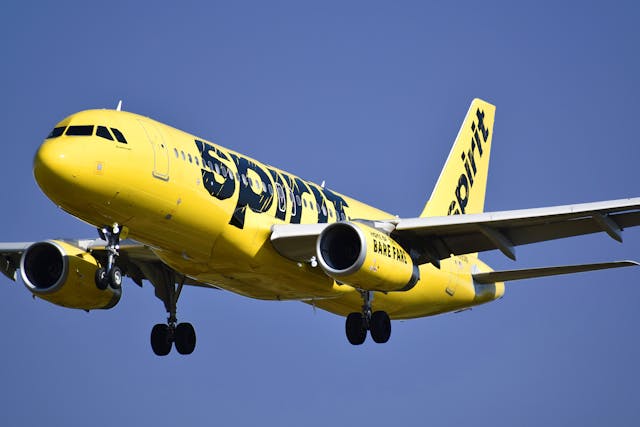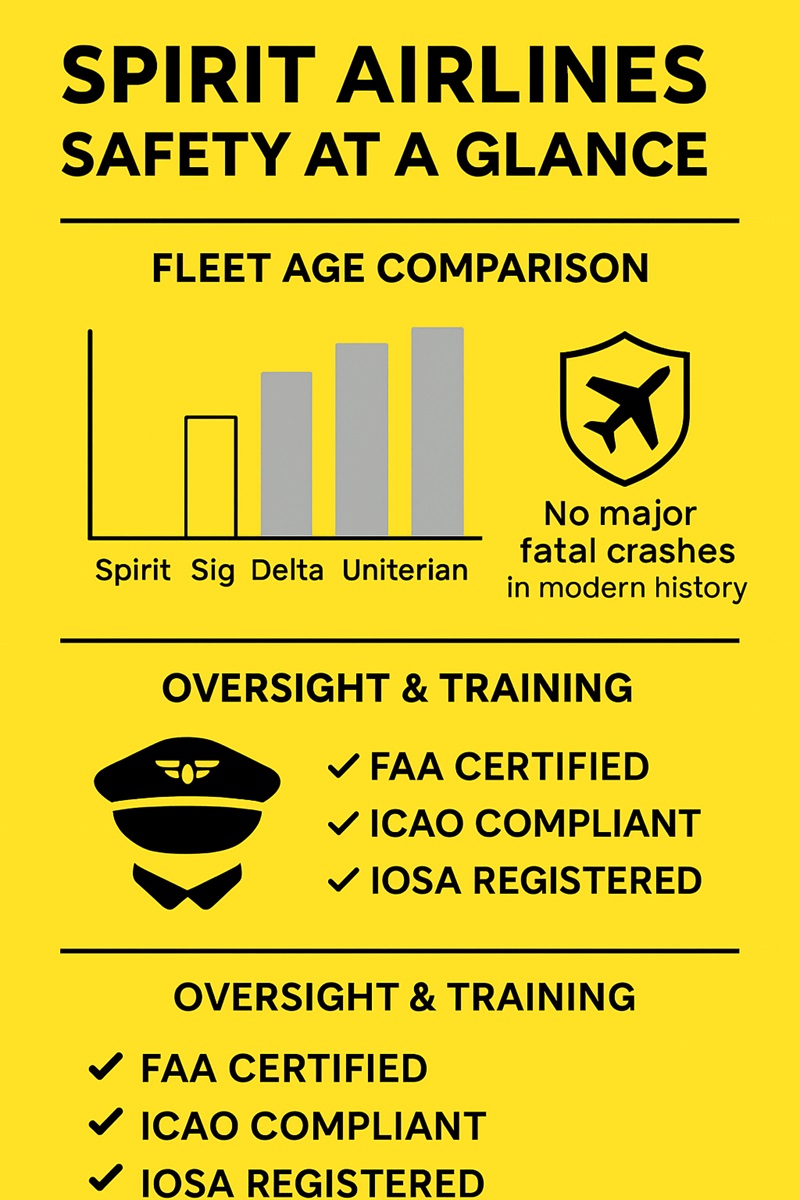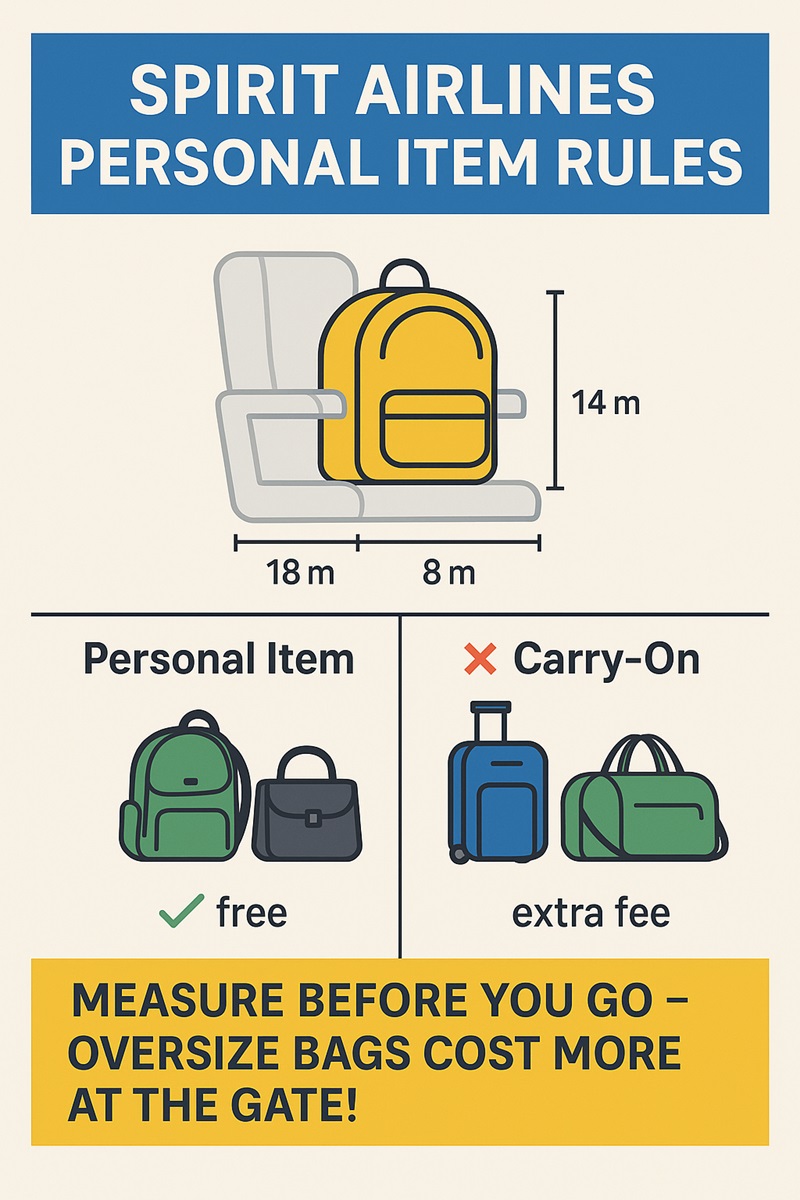Taking your very first flight can be exciting—but also a little nerve-wracking. Add in the reputation of a budget airline like Spirit, and it’s natural for first-time flyers to ask: “Is Spirit Airlines safe?”
The short answer is yes. Spirit Airlines operates under the same Federal Aviation Administration (FAA) safety regulations as all major U.S. carriers. Its fleet is relatively young, its pilots undergo rigorous training, and its planes are maintained to the same standards as Delta, American, or United.
But safety isn’t the only thing on a new traveler’s mind. If you’ve never flown before—or never flown Spirit—you may be wondering how safe the experience really feels, what to expect at the airport, and how to prepare so your first flight is stress-free. This editorial guide breaks down everything you need to know.
Is Spirit Airlines Safe? (Quick Answer)
Yes, Spirit Airlines is safe. It operates under the same FAA safety regulations as all major U.S. carriers, flies a modern Airbus fleet with an average age of about seven years, and has no record of major crashes in recent decades. Spirit’s safety standards match those of larger airlines like Delta and United—the difference lies in service and comfort, not safety.
Spirit Airlines Safety Record: The Facts
Spirit’s safety record is as strong as any big U.S. airline. It follows the same FAA rules, uses a modern fleet, and has avoided major crashes for decades. Here’s the breakdown:
- FAA Oversight: Spirit is FAA-certified. Every plane, pilot, and mechanic must meet strict U.S. safety rules.
- Fleet Details: Spirit mostly flies Airbus A320 planes. These are some of the most trusted jets in the world. The average plane is under 7 years old—newer than many other airlines.
- Accident History: Spirit has never had a major crash in modern times. Like all airlines, small incidents happen, but they are minor and normal.
- Global Ranking: Spirit meets international safety standards, according to AirlineRatings.com.
Flying Spirit is statistically just as safe as flying Delta, United, or Southwest.
Spirit Airlines Fleet Age & Safety Comparison
When comparing Spirit’s aircraft to other U.S. airlines, the numbers tell a reassuring story:
| Airline | Average Fleet Age | Primary Aircraft | Safety Oversight |
| Spirit | ~7 years | Airbus A320 family | FAA + ICAO + IOSA |
| Delta | ~15 years | Mixed Boeing & Airbus | FAA + ICAO + IOSA |
| United | ~16 years | Mixed Boeing & Airbus | FAA + ICAO + IOSA |
| American | ~12 years | Boeing & Airbus | FAA + ICAO + IOSA |
Spirit’s fleet is one of the youngest among U.S. carriers, which generally means fewer mechanical issues, lower maintenance risk, and greater efficiency.
Is Spirit Airlines Safe After Recent Airline Safety Incidents?
Safety headlines can rattle nervous flyers. When any airline makes an emergency landing or cancels a flight for technical reasons, the story often spreads quickly. But the reality is less alarming: most of these events are routine precautions.
Spirit, like all airlines, has experienced precautionary landings and weather diversions, but it has not had a fatal crash in its modern operating history. Every incident is investigated by the FAA or NTSB, and outcomes usually confirm that safety systems worked exactly as intended.
Takeaway: High-profile headlines don’t mean higher risk. Spirit remains under the same strict oversight as every U.S. airline.
Spirit Airlines: History, Reputation, and Controversies
Spirit Airlines started in 1983 as Charter One, a small charter service in Michigan. In 1992, it became Spirit Airlines and soon grew into one of the largest low-cost airlines in the U.S. Today, its biggest hubs are in Fort Lauderdale, Orlando, and Las Vegas.
The airline built a strong reputation for cheap fares. Many budget travelers like Spirit because it makes flying more affordable. But low prices come with trade-offs. Passengers often complain about small seats, many extra fees, and fewer comforts compared to larger airlines.
Over the years, Spirit has faced lawsuits about hidden fees, ranked low in customer service surveys, and had labor disputes. In 2022–2023, its proposed mergers with Frontier and later JetBlue also brought national attention.
Impact on safety perception: These issues affect how travelers feel about Spirit, but they do not mean the airline is unsafe. Spirit’s main challenges are about comfort and service, not safety standards.
What Makes First-Time Flyers Nervous
Flying for the first time is rarely about facts—it’s about fear. Turbulence, for example, can feel scary when the plane shakes. But pilots compare it to bumps on the road: annoying, yes, but not unsafe.
Some travelers also worry about flying on budget airlines. They may think low prices mean less care for safety. In Spirit’s case, the savings come from cutting extras like free snacks and legroom—not from skipping safety checks.
Even boarding can feel stressful. Spirit boards groups fast, and the cabin feels crowded with narrow rows. For new flyers, the rush can raise anxiety. But crews are trained to help, and once seated, most people start to relax.
Why Budget Airline ≠ Unsafe Airline
One of the most persistent myths is that low-cost carriers are less safe. In reality:
- Safety Costs Are Non-Negotiable: FAA mandates apply equally to every airline.
- Savings Come From Services, Not Safety: Spirit reduces costs by unbundling baggage, snacks, and seat selection—not by skimping on maintenance.
- Industry Evidence: Accident statistics show no meaningful safety gap between ULCCs and legacy carriers.
Truth: Flying Spirit is just as safe as Delta or United—the trade-off is fewer perks, not lower safety.
Is Spirit Airlines Safe Compared to Other Airlines?
This is one of the most Googled questions about Spirit.
- Regulations: FAA standards apply equally to budget and premium carriers.
- Maintenance: Spirit outsources maintenance to certified contractors, a standard practice in aviation.
- Differences: The real gap is in comfort and service—not safety.
Spirit Airlines & International Safety Standards
Spirit doesn’t just meet U.S. regulations—it complies with global benchmarks:
- FAA Oversight: Daily inspections, mandatory certifications, and routine maintenance.
- ICAO Compliance: Adheres to International Civil Aviation Organization standards.
- IOSA Registration: Completed IATA’s Operational Safety Audit, used worldwide.
Result: Spirit is recognized internationally for adhering to aviation safety best practices.
Preparing for Your First Flight with Spirit Airlines
Flying Spirit is safe, but it requires preparation. To make your first trip smoother:
- Before Booking: Check baggage policies and pay in advance if you want to pick your seat or bring a larger bag.
- At the Airport: Arrive early (2 hours for domestic flights) and check in online to save time.
- Boarding Process: Spirit calls boarding groups quickly—listen carefully to announcements.
- In-Flight: Expect fewer amenities. Bring your own water, snacks, pillow, and entertainment.
Spirit Airlines Personal Item Dimensions: What You Need to Know
One of Spirit’s strictest rules is baggage sizing:
- Allowance: One free personal item up to 18 x 14 x 8 inches (45 x 35 x 20 cm), fitting under the seat.
- Examples: A small backpack, laptop bag, or purse.
- Carry-On Fees: Larger bags count as carry-ons and cost extra, with the highest fees charged at the gate.
- Pro Tip: Measure your bag before traveling—oversized “personal items” can cost more than the ticket if caught at boarding.
Safety Tips for First-Time Flyers
- Always wear your seatbelt when seated.
- Pay attention to crew demonstrations.
- Sit closer to the front if turbulence makes you anxious.
- Stay hydrated and eat lightly.
- Bring distractions like music, books, or podcasts.
Spirit Airlines Pilot Training & Crew Safety
Spirit’s pilots don’t just show up and fly. Each undergoes years of training and must log at least 1,500 flight hours before qualifying. They practice emergency scenarios in simulators and return for recurrent training every 6–12 months to sharpen their skills.
Cabin crews train just as intensively. From evacuation procedures and CPR to turbulence management, their first priority is passenger safety.
Key reassurance: Spirit’s crews are trained first to protect you—not just to serve you.
Myths vs. Facts About Spirit Airlines Safety
| Myth | Fact |
| “Cheap fares mean unsafe planes.” | ✘ False. FAA requires the same safety standards for all airlines. |
| “Spirit’s planes are old.” | ✘ False. Fleet average age is ~7 years, younger than Delta or United. |
| “Budget airlines skip safety checks.” | ✘ False. FAA inspections and certifications are identical across carriers. |
FAQs for First-Time Flyers on Spirit Airlines
Q: Has Spirit Airlines ever had a fatal crash?
No. Spirit has not had a major fatal crash in its modern operating history.
Q: Is Spirit Airlines safe for international flights?
Yes. Spirit flies under the same FAA and ICAO rules whether in the U.S., Latin America, or the Caribbean.
Q: Why does Spirit get bad reviews if it’s safe?
Complaints focus on customer service and comfort—not safety.
Q: How does Spirit’s safety compare to Southwest or JetBlue?
All three meet FAA and ICAO standards. Differences are in legroom and perks, not safety.
Q: Is Spirit Airlines good for nervous flyers?
Yes—with preparation. Choose a preferred seat, bring entertainment, and measure your bag to reduce stress.
Conclusion
So, is Spirit Airlines safe for first-time flyers? Yes. Spirit follows the same U.S. and global safety rules as every major airline. It flies a modern Airbus fleet, and its pilots and crews go through strict training.
What first-time travelers should expect are the quirks of a budget airline: fewer extras, tight seats, and clear baggage rules. With a little planning, your first Spirit flight can be safe, smooth, and affordable.
✈️ Final tip: Focus on being prepared, not just on the low fares. That way, you’ll feel ready and confident when you step on board.






